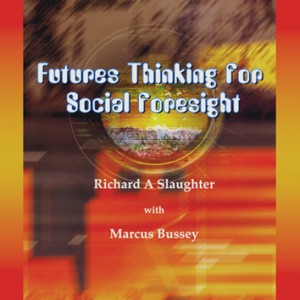 Futures Thinking for Social Foresight (FTSF) brings together a range of tried and tested resources for helping young people to develop a wide range of futures concepts and capabilities. Some of the material presented here has been drawn from two previous resource books: Futures Tools and Techniques and Futures Concepts and Powerful Ideas. The best of this material was up-dated and revised for this publication and new, more recent, material added. Written by two experienced educators it provides a unique and straightforward introduction to Futures Studies and Applied Foresight for junior and secondary students. The entire contents are copyright free for teachers and students and can therefore be reproduced within schools as necessary. (This obviously excludes re-publication in any medium.) The work is available in PDF form (both as a whole and in separate sections) and also as a CD-ROM. All are available in the Shop section of this site.
Futures Thinking for Social Foresight (FTSF) brings together a range of tried and tested resources for helping young people to develop a wide range of futures concepts and capabilities. Some of the material presented here has been drawn from two previous resource books: Futures Tools and Techniques and Futures Concepts and Powerful Ideas. The best of this material was up-dated and revised for this publication and new, more recent, material added. Written by two experienced educators it provides a unique and straightforward introduction to Futures Studies and Applied Foresight for junior and secondary students. The entire contents are copyright free for teachers and students and can therefore be reproduced within schools as necessary. (This obviously excludes re-publication in any medium.) The work is available in PDF form (both as a whole and in separate sections) and also as a CD-ROM. All are available in the Shop section of this site.
The work is divided into five sections: Mapping Futures Studies: Key Concepts; Contexts and Applications; Futures Concepts and Related Techniques; Methods; and finally, Futures Thinking for Social Foresight. See below for the Introduction, Glossary and Author Biographies.
Futures Thinking for Social Foresight Introduction / How to use this book (Read more)
Glossary of Futures Terms (Read more)
Author Biographies (Read more)
Now available from the FI shop as five separate PDF files ready for classroom use.
This entry-level CD-ROM is available as a set of pdf files, one for each section. They can be duplicated in any medium and made available in part or as a whole. They provide teachers and students with a straightforward, flexible and adaptable introduction to futures studies and applied foresight. Those seeking to help young people develop futures literacy will find numerous practical, tried and tested starting points. There are five main sections.
- Mapping Futures Studies – Key concepts
Contains 16 sections including: What is futures study? How can we study futures? Alternatives and choices and Questions about futures.
- Context and Applications
Contains 18 sections including: Utopia and Dystopia; the loop of futures scanning; Cultural editing and Futures in education.
- Futures Concepts and Related Techniques
Contains 21 sections including: Metaphors of time and the future; Extending the present; Time-frames; Images and their power and Creativity and futures.
- Methods
Contains 27 sections including Environmental scanning; Optimism and pessimism; An imaging workshop; Simple scenarios and Social innovations.
- Futures Thinking for Social Foresight
Contains 13 sections including: Futures literacy; Safeguarding the sources of life; Choosing limits; Waging peace and Building social foresight.
In addition to these practical and user-friendly sections, a number of ‘reflections’ or short pieces are included that invite deeper consideration. Overall, Futures Thinking for Social Foresight is accessible and easy to use. It provides access to some of the best thinking and most useful options available for young people in futures studies and applied foresight. It can be used with students of all ages. See reviews by two leading practitioners below.
Practitioner Reviews of Futures Thinking for Social Foresight (Read more)
